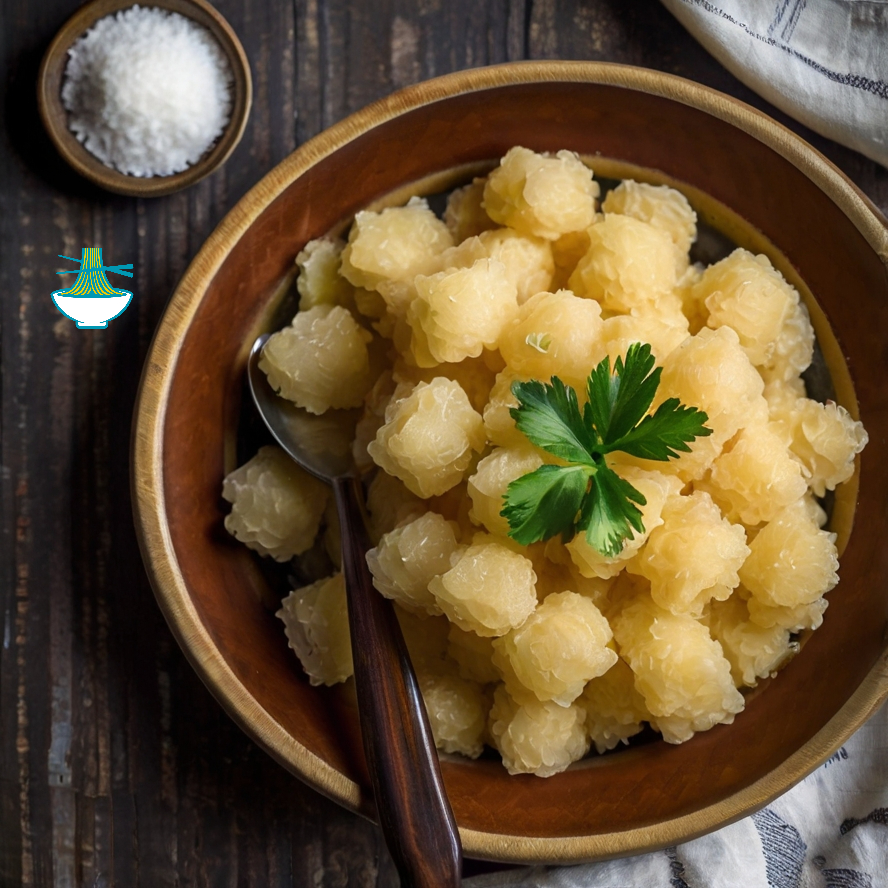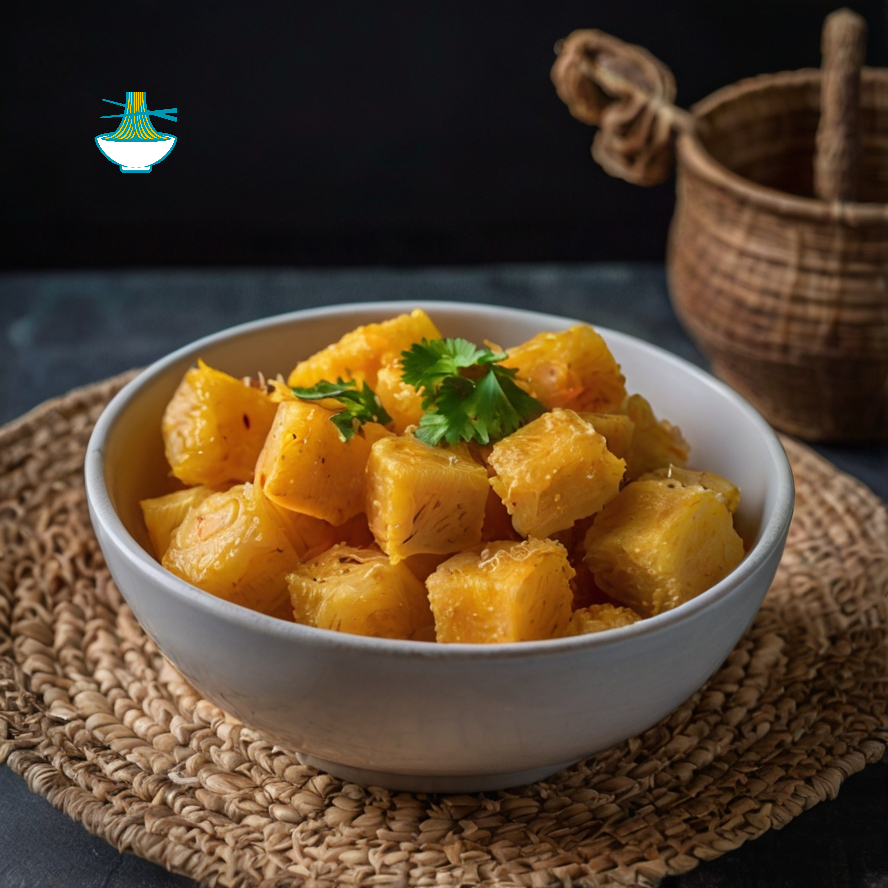Gari is a popular food made from dried grated cassava, a starchy root vegetable, and is often used as a side dish or a quick meal when mixed with water and sugar. This dish is rich in carbohydrates, providing a quick source of energy, and contains dietary fiber that supports digestion. Gari is also a good source of vitamin C, which helps strengthen the immune system. However, it is important to note that Gari is primarily a carbohydrate source and should be consumed with a balance of protein and vegetables for a well-rounded meal. When prepared with care, Gari offers a versatile and nutritious addition to any meal, making it a great choice for those seeking to improve their intake of essential nutrients, minerals, and vitamins.
Ingredients:
- 2 cups of Gari
- 1/2 cup water (or more for desired consistency)
- 2 tablespoons sugar (optional)
- 1/4 teaspoon salt (optional)
- 1 tablespoon butter (optional)
- 1/4 cup milk (optional)
Instructions:
Step 1: Select the Best Gari
Before you start cooking, make sure you're using high-quality Gari. Look for Gari that is finely grated, dry, and free from impurities. You can find it in African or international grocery stores, but if you're unsure, go for a trusted brand or supplier that guarantees freshness.
Pro Tip: Check the label for additives. Pure Gari will be just cassava, without any extra ingredients.
Step 2: Hydrate the Gari with Warm Water
The key to achieving the right texture is how you add water. Use warm—not hot—water. The warm water helps the Gari absorb the liquid quickly and evenly, which results in a smooth texture. Slowly pour the water while stirring continuously.
Pro Tip: Start with 1/2 cup of warm water for every 2 cups of Gari. Adjust based on your desired consistency—more water for a softer, more porridge-like texture, less for a firmer, grainier result.
Step 3: Add Optional Ingredients for Enhanced Flavor
At this point, you can customize your Gari. Add a pinch of salt for savory flavor or 1-2 tablespoons of sugar for a slight sweetness. For a creamier, richer Gari, consider adding butter or a splash of milk.
Pro Tip: Don't overdo the butter or milk. Start with 1 tablespoon of butter or 1/4 cup of milk, then adjust if necessary.
Step 4: Mix Until Fully Incorporated
Stir the mixture thoroughly to ensure the water and any added ingredients (sugar, salt, milk) are fully integrated into the Gari. This step is crucial for achieving a uniform texture.
Pro Tip: If you prefer a smoother texture, mix for longer. If you like it a bit grainy, stop mixing earlier.
Step 5: Serve Immediately for the Best Taste
Gari is best served right after it's prepared, while it’s still warm and fluffy. Serve it as a side dish with grilled meats, fish, or vegetables.
Pro Tip: If you’re not serving immediately, store Gari in an airtight container. Reheat with a little water or milk to maintain the texture.
Step 6: Experiment with Pairings
Gari is extremely versatile and can be paired with many dishes. For a more traditional Liberian experience, try it with a pepper sauce, stewed meats, or fried fish.
Pro Tip: The texture and flavor of Gari can vary depending on the water-to-Gari ratio, so don’t be afraid to experiment to find the perfect balance that works for you.
Additional Preparation Methods for Gari:
Gari, while traditionally prepared with water and optional sugar, butter, and milk, can be customized in various ways to suit different dietary preferences. Here are a few alternative preparation methods:
- With Vegetables: You can enhance the nutritional profile of Gari by adding cooked vegetables such as spinach, kale, or carrots. These vegetables not only add color and flavor but also boost the meal with additional vitamins and minerals.
- With Plant-Based Proteins: For those following a plant-based diet, tofu or lentils can be added instead of dairy or animal-based ingredients. Tofu provides a good source of protein and can be fried or sautéed with spices for extra flavor. Lentils, on the other hand, can be cooked alongside Gari to make the dish more filling and nutrient-dense.
- Spices and Seasonings: Experimenting with spices such as turmeric, ginger, or garlic can also elevate the taste and provide added health benefits, such as anti-inflammatory properties.
Side Dish Ideas for Gari:
Gari is a versatile dish that pairs well with various side dishes to create a balanced and flavorful meal:
- Grilled Meats: Gari complements grilled meats such as chicken, beef, or fish. The smoky flavor of grilled proteins enhances the mild taste of Gari, making it a satisfying combination.
- Vegetable Stews: Gari can also be served alongside vegetable stews, such as a hearty tomato-based soup or a rich okra stew, which will add more nutrients and fiber to the meal.
- Salads: A fresh vegetable salad with greens like lettuce, cucumber, and tomatoes can provide a crunchy contrast to the soft texture of Gari.
Note
Impact of Excessive Consumption of Sugar or Butter:
Consuming too much sugar or butter in Gari can have long-term health effects. While these ingredients enhance flavor, they should be consumed in moderation:
- Excessive Sugar: High sugar intake can contribute to weight gain, blood sugar imbalances, and an increased risk of type 2 diabetes. It's important to limit the amount of sugar added to Gari and opt for natural sweeteners like honey or fruit when possible.
- Excessive Butter: Butter is high in saturated fats, which, when consumed in excess, can increase cholesterol levels and raise the risk of heart disease. Using butter sparingly or substituting it with healthier fats, such as olive oil or avocado, can help improve the dish's nutritional balance.
Frequently Asked Questions (FAQs):
Can Gari be eaten as a main meal?
- Yes, Gari can be consumed as a main meal when combined with protein sources like beans, lentils, or grilled meats, as well as vegetables. This will make the meal more nutritionally complete and balanced.
What are the other health benefits of Gari?
- Gari is a good source of dietary fiber, which supports digestion and promotes a healthy gut. Additionally, it provides quick energy due to its carbohydrate content, making it a suitable option for an energy boost.
Can Gari be included in a vegetarian or vegan diet?
- Yes, Gari can easily be modified for a vegetarian or vegan diet by replacing butter or milk with plant-based alternatives like coconut milk or olive oil. Additionally, adding lentils, tofu, or other plant-based proteins enhances the dish.
Can Gari be stored for later use?
- While Gari is quick to prepare, it can be stored in the fridge for a few hours if necessary. However, it is best consumed immediately after preparation to maintain its soft and tender texture. If stored, it may become firmer.
Are there alternatives to Gari if it's not available?
- If Gari is not available, you can use rice or quinoa as an alternative. Both of these grains are rich in carbohydrates and provide similar energy-boosting benefits when combined with other dishes.

Nutritional values and benefits:
1. 1 Cup Gari (150g)
- Calories: 450
- Carbohydrates: 110g
- Protein: 0g
- Fat: 0g
- Sodium: 15mg
- Cholesterol: 0mg
Vitamins:
- Vitamin C: 1.5mg (2% DV)
Minerals:
- Iron: 0.6mg (3% DV)
- Calcium: 10mg (1% DV)
- Nutritional Benefit: Gari is a rich source of carbohydrates, providing quick energy. It also contains small amounts of iron, which helps in oxygen transport, and vitamin C, which supports immune health.
2. 1/2 Cup Water
- Calories: 0
- Carbohydrates: 0g
- Protein: 0g
- Fat: 0g
- Sodium: 0mg
- Cholesterol: 0mg
Vitamins & Minerals:
- No significant amounts
- Nutritional Benefit: Water is essential for hydration, supporting various body functions, including digestion, nutrient absorption, and temperature regulation.
3. 2 Tablespoons Sugar
- Calories: 96
- Carbohydrates: 24g
- Protein: 0g
- Fat: 0g
- Sodium: 0mg
- Cholesterol: 0mg
Vitamins & Minerals:
- No significant amounts
- Nutritional Benefit: Sugar provides quick energy but should be consumed in moderation. Excess sugar intake can lead to weight gain and other health issues if not balanced properly.
4. 1/4 Teaspoon Salt
- Calories: 0
- Carbohydrates: 0g
- Protein: 0g
- Fat: 0g
- Sodium: 600mg (25% DV)
- Cholesterol: 0mg
Vitamins & Minerals:
- No significant amounts
- Nutritional Benefit: Salt is essential for fluid balance and nerve function but should be consumed in moderation to avoid excessive sodium intake, which can lead to high blood pressure.
5. 1 Tablespoon Butter
- Calories: 102
- Carbohydrates: 0g
- Protein: 0g
- Fat: 12g
- Saturated fat: 7g
- Sodium: 31mg
- Cholesterol: 31mg
Vitamins:
- Vitamin A: 355 IU (7% DV)
Minerals:
- Calcium: 3mg (1% DV)
- Nutritional Benefit: Butter provides healthy fats and vitamin A, which supports vision and skin health. However, due to its high saturated fat content, it should be used sparingly.
6. 1/4 Cup Milk (Optional)
- Calories: 40
- Carbohydrates: 5g
- Protein: 3g
- Fat: 2g
- Sodium: 35mg
- Cholesterol: 10mg
Vitamins:
- Vitamin A: 150 IU (3% DV)
- Vitamin D: 2.5mcg (10% DV)
Minerals:
- Calcium: 120mg (12% DV)
- Nutritional Benefit: Milk provides protein, calcium, and vitamin D, which are essential for bone health and muscle function. It also offers a source of hydration.
Gari is a versatile and energy-dense food, offering quick energy and some essential nutrients. However, it's best when complemented with other dishes rich in protein, vegetables, and healthy fats for a balanced meal.


Comments